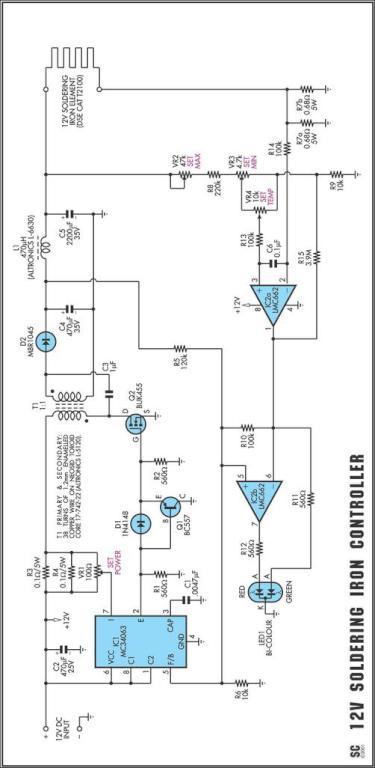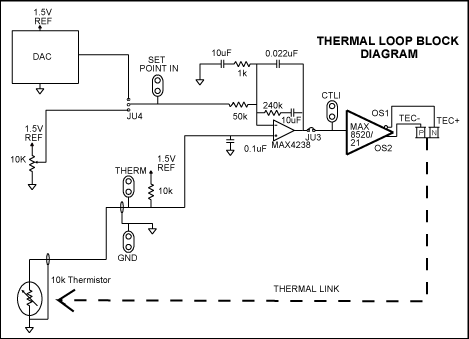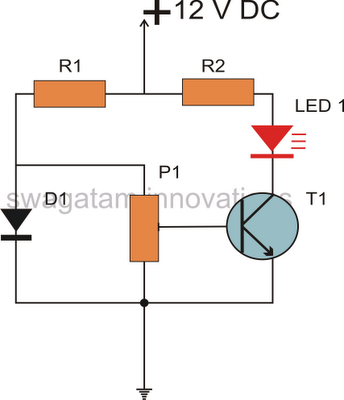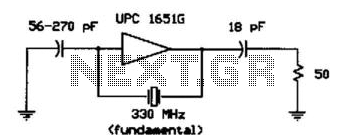
antenna tuning unit atu for 27 mhz cb
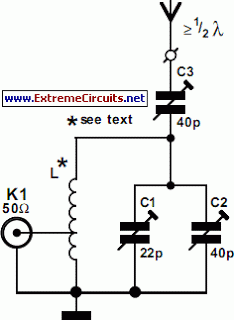
This antenna tuning unit (ATU) allows half-wavelength or longer wire antennas to be matched to the 50-ohm antenna input of 27-MHz Citizens Band (CB) radios. The ATU is particularly useful in situations where a wire antenna is less visually intrusive than a roof-mounted vertical or ground-plane antenna. It is also suitable for improvised antennas used by active CB users at camping sites, as it enables a length of wire to function effectively as an antenna stretched between a tree branch and a tent post. The wire ends need to be isolated using short lengths of nylon wire. The ATU can even tune a length of barbed wire to 27 MHz. The coil in the circuit consists of 11 turns of silver-plated copper wire with a diameter of approximately 1 mm (SWG20). The internal diameter of the coil is 15 mm, and it is extended to a length of about 4 cm. The tap for the antenna cable to the CB radio is made approximately 2 turns from the cold (ground) side. Two trimmer capacitors are utilized for tuning the ATU: a smaller one, C1, for fine tuning, and a larger one, C2, for coarse tuning. Adjustments are made using an in-line SWR (standing-wave ratio) meter, which is commonly available to CB enthusiasts. To tune, select channel 20 on the CB radio and set C1 and C3 to mid-travel. Press the PTT button and adjust C2 for the lowest SWR reading. Subsequently, alternately adjust C3 and C2 to achieve the closest possible 1:1 SWR reading, with C1 fine-tuned for optimal performance. Once set, there is no need to readjust the ATU unless a different antenna is used. If the wire antenna measures exactly 5.5 meters, C3 should be set to maximum capacitance. Although designed for half-wavelength or longer antennas, the ATU can also accommodate shorter antennas. For instance, if the antenna is only 3 meters long, the remaining 2.5 meters must be wound onto a length of PVC tubing to create a base-loaded coil (BLC), effectively shortening the antenna electrically. The actual length of the added coil may be adjusted through trial and error. The ATU should be housed in an all-metal case to prevent unwanted radiation, with trimmers accessed through small holes. The connection to the CB radio is optimally made using an SO239 (UHF) or BNC style socket on the ATU box, along with a short 50-ohm coaxial cable with matching plugs.
The antenna tuning unit (ATU) is an essential component for optimizing the performance of wire antennas, especially in applications where space and aesthetics are considerations. The design allows for the effective matching of various antenna lengths to the standard 50-ohm input of CB radios, facilitating reliable communication over the 27 MHz band. The use of trimmer capacitors for tuning provides flexibility in achieving the best possible standing-wave ratio (SWR), which is crucial for minimizing power loss and maximizing transmission efficiency.
The construction of the coil with 11 turns of silver-plated copper wire is particularly noteworthy, as the choice of materials and dimensions directly influences the tuning range and efficiency of the ATU. The specified dimensions, including the internal diameter and coil length, ensure that the inductance is suitable for the desired frequency range. The incorporation of a BLC design for shorter antennas demonstrates the versatility of the ATU, allowing users to adapt to various operational scenarios without compromising performance.
The requirement for an all-metal enclosure is a critical design consideration, as it mitigates the risks of electromagnetic interference and radiation that could affect both the ATU's performance and surrounding electronic devices. The accessibility of the trimmer capacitors through small holes allows for convenient adjustments while maintaining the integrity of the enclosure.
In summary, this ATU is a versatile and effective solution for matching wire antennas to CB radios, particularly in portable or temporary setups. Its thoughtful design and construction ensure reliable performance, making it a valuable tool for CB enthusiasts and operators in diverse environments.This antenna tuning unit (ATU) enables half-wavelength or longer wire antennas to be matched to the 50- antenna input of 27-MHz CitizensG ‚¬ Band (CB) rigs. The ATU is useful in those cases where a wire antenna is less obtrusive than a roof-mounted G ‚¬ verticalG ‚¬ or ground-plane.
It is also great for G ‚¬ improvisedG ‚¬ antenna s used by active CB users on camping sites and the like because it allows a length of wire to be used as a fairly effective antenna hung between, say, a tree branch at one side and a tent post, at the other. Obviously, the wire ends then have to be isolated using, for example, short lengths of nylon wire. It is even possible to use the ATU to tune a length of barbed wire to 27 MHz. The coil in the circuit consists of 11 turns of silver-plated copper wire with a diameter of about 1 mm (SWG20).
The internal diameter of the coil is 15 mm, and it is stretched to a length of about 4 cm. The tap for the antenna cable to the CB radio is made at about 2 turns from the cold (ground) side. Two trimmer capacitors are available for tuning the ATU. The smaller one, C1, for fine tuning, and the larger one, C2, for coarse tuning. The trimmers are adjusted with the aid of an in-line SWR (standing-wave ratio) meter which most CB enthusiasts will have, or should be able to obtain on loan. Select channel 20 on the CB rig and set C1 and C3 to mid-travel. Press the PTT button and adjust C2 for the best (that is, lowest) SWR reading. Next, alternately adjust C3 and C2 until you get as close as possible to a 1:1 SWR reading. C1 may then be tweaked for an even better value. No need to re-adjust the ATU until another antenna is used. In case the length of the wire antenna is exactly 5. 5 metres, then C3 is set to maximum capacitance. Although the ATU is designed for half-wavelength or longer antennas, it may also be used for physically shorter antennas.
For example, if antenna has a physical length of only 3 metres, then the remaining 2. 5 metres has to be wound on a length of PVC tubing. This creates a so-called BLC (base-loaded coil) electrically shortened antenna. In practice, the added coil can be made somewhat shorter than the theoretical value, so the actual length is best determined by trial and error. Finally, the ATU has to be built in an all-metal case to prevent unwanted radiation. The trimmers are than accessed through small holes. The connection to the CB radio is best made using an SO239 (G ‚¬ UHFG ‚¬ ) or BNC style socket on the ATU box and a short 50-W coax cable with matching plugs.
🔗 External reference
The antenna tuning unit (ATU) is an essential component for optimizing the performance of wire antennas, especially in applications where space and aesthetics are considerations. The design allows for the effective matching of various antenna lengths to the standard 50-ohm input of CB radios, facilitating reliable communication over the 27 MHz band. The use of trimmer capacitors for tuning provides flexibility in achieving the best possible standing-wave ratio (SWR), which is crucial for minimizing power loss and maximizing transmission efficiency.
The construction of the coil with 11 turns of silver-plated copper wire is particularly noteworthy, as the choice of materials and dimensions directly influences the tuning range and efficiency of the ATU. The specified dimensions, including the internal diameter and coil length, ensure that the inductance is suitable for the desired frequency range. The incorporation of a BLC design for shorter antennas demonstrates the versatility of the ATU, allowing users to adapt to various operational scenarios without compromising performance.
The requirement for an all-metal enclosure is a critical design consideration, as it mitigates the risks of electromagnetic interference and radiation that could affect both the ATU's performance and surrounding electronic devices. The accessibility of the trimmer capacitors through small holes allows for convenient adjustments while maintaining the integrity of the enclosure.
In summary, this ATU is a versatile and effective solution for matching wire antennas to CB radios, particularly in portable or temporary setups. Its thoughtful design and construction ensure reliable performance, making it a valuable tool for CB enthusiasts and operators in diverse environments.This antenna tuning unit (ATU) enables half-wavelength or longer wire antennas to be matched to the 50- antenna input of 27-MHz CitizensG ‚¬ Band (CB) rigs. The ATU is useful in those cases where a wire antenna is less obtrusive than a roof-mounted G ‚¬ verticalG ‚¬ or ground-plane.
It is also great for G ‚¬ improvisedG ‚¬ antenna s used by active CB users on camping sites and the like because it allows a length of wire to be used as a fairly effective antenna hung between, say, a tree branch at one side and a tent post, at the other. Obviously, the wire ends then have to be isolated using, for example, short lengths of nylon wire. It is even possible to use the ATU to tune a length of barbed wire to 27 MHz. The coil in the circuit consists of 11 turns of silver-plated copper wire with a diameter of about 1 mm (SWG20).
The internal diameter of the coil is 15 mm, and it is stretched to a length of about 4 cm. The tap for the antenna cable to the CB radio is made at about 2 turns from the cold (ground) side. Two trimmer capacitors are available for tuning the ATU. The smaller one, C1, for fine tuning, and the larger one, C2, for coarse tuning. The trimmers are adjusted with the aid of an in-line SWR (standing-wave ratio) meter which most CB enthusiasts will have, or should be able to obtain on loan. Select channel 20 on the CB rig and set C1 and C3 to mid-travel. Press the PTT button and adjust C2 for the best (that is, lowest) SWR reading. Next, alternately adjust C3 and C2 until you get as close as possible to a 1:1 SWR reading. C1 may then be tweaked for an even better value. No need to re-adjust the ATU until another antenna is used. In case the length of the wire antenna is exactly 5. 5 metres, then C3 is set to maximum capacitance. Although the ATU is designed for half-wavelength or longer antennas, it may also be used for physically shorter antennas.
For example, if antenna has a physical length of only 3 metres, then the remaining 2. 5 metres has to be wound on a length of PVC tubing. This creates a so-called BLC (base-loaded coil) electrically shortened antenna. In practice, the added coil can be made somewhat shorter than the theoretical value, so the actual length is best determined by trial and error. Finally, the ATU has to be built in an all-metal case to prevent unwanted radiation. The trimmers are than accessed through small holes. The connection to the CB radio is best made using an SO239 (G ‚¬ UHFG ‚¬ ) or BNC style socket on the ATU box and a short 50-W coax cable with matching plugs.
🔗 External reference

